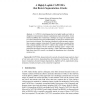Free Online Productivity Tools
i2Speak
i2Symbol
i2OCR
iTex2Img
iWeb2Print
iWeb2Shot
i2Type
iPdf2Split
iPdf2Merge
i2Bopomofo
i2Arabic
i2Style
i2Image
i2PDF
iLatex2Rtf
Sci2ools
HIP
2005
Springer
2005
Springer
A Highly Legible CAPTCHA That Resists Segmentation Attacks
A CAPTCHA which humans find to be highly legible and which is designed to resist automatic character–segmentation attacks is described. As first detailed in [BR05], these ‘ScatterType’ challenges are images of machine-print text whose characters have been pseudorandomly cut into pieces which have then been forced to drift apart. This scattering is designed to repel automatic segmentthen-recognize computer vision attacks. We report results from an analysis of data from a human legibility trial with 57 volunteers that yielded 4275 CAPTCHA challenges and responses. We have located an operating regime—ranges of the parameters that control cutting and scattering—within which human legibility is high (better than 95% correct) even though the degradations due to scattering remain severe.
Automatic Character–segmentation Attacks | Cryptography | HIP 2005 | Human Legibility | Human Legibility Trial |
| Added | 27 Jun 2010 |
| Updated | 27 Jun 2010 |
| Type | Conference |
| Year | 2005 |
| Where | HIP |
| Authors | Henry S. Baird, Michael A. Moll, Sui-Yu Wang |
Comments (0)

